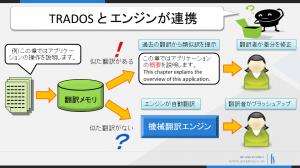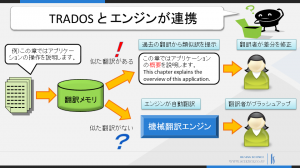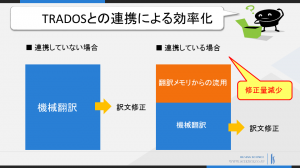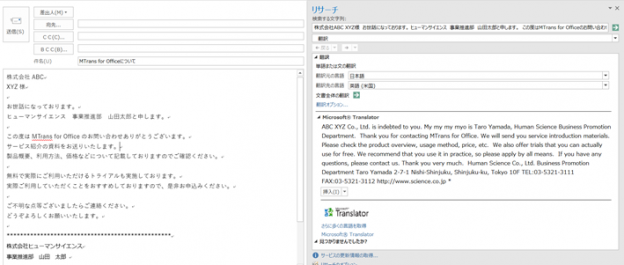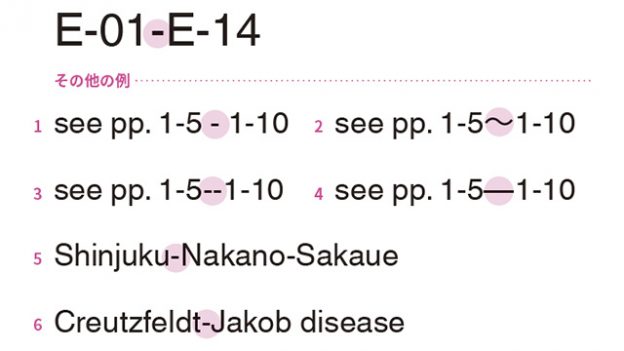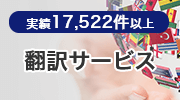One of the common questions asked when introducing machine translation is,
"Can we make use of our existing translation assets?"
Many of you seem to have a desire to utilize databases of source and translated texts that have been accumulated in formats such as translation memories, for machine translation as well.
This time, we will introduce the combination of machine translation engine and translation support tool, which can further improve efficiency while utilizing translation assets.
● If there is a similar translation in the corpus, is it the correct translation?
When it comes to utilizing past assets in machine translation, the first thing that comes to mind is "corpus". By loading a collection of translations of past source texts and target texts into a statistical-based engine as a "corpus", it is possible to improve the accuracy of translation.
However, there are also drawbacks to utilizing this asset.
This is the difficult part of a statistical-based engine,
where it is said that just because there are similar translations in the corpus, it does not necessarily mean they are good translations.
Explanation using English-Japanese translation as an example.
Let's say the following translation was included in the corpus.
——————————————————————
Press the [Finish] button to close the window.
Press the [Finish] button to close the window.
——————————————————————
In doing so, I can't help but feel that a relatively "good translation" will be output for the following original text.
——————————————————————
Press the [OK] button to close the window.
——————————————————————
However, in reality, this is the translation that will be output.
——————————————————————
Press [OK] button to close the window
——————————————————————
※This is just an example that has been simplified for clarity and does not represent the output results or translation quality of any specific engine.
There are various factors that could have caused this, such as the analysis by the engine not going as planned, being influenced by other translations in the corpus, etc.
Some may think, "If it's going to turn out like this, wouldn't it be faster to refer to past translations and translate it yourself instead of post-editing it?"
Actually, that's exactly right!
● If there is a similar translation, use a translation support tool to translate it.
Translation support tools such as MTrans for Trados
will provide a numerical representation of the similarity between past translation assets (=translation memory)
if there are similar translations.
In the above example, if there is "Press the [Finish] button to close the window." in the translation memory, when trying to translate "Press the [OK] button to close the window.", it will suggest "There is a 90% match for the translation."
Therefore, if there is a translation with a high match rate in the translation memory, refer to it and translate,
only if there is no such translation, perform machine translation + post-editing to improve accuracy and
proceed with translation efficiently.
In some of our cases,
we have set a certain threshold for matching and only applied machine translation to those with lower rates,
while those with higher rates were translated by human hands with reference to translation memory,
resulting in a reduction of translation costs by about 15%.
"So, how much matching rate should we set as the threshold?" Some of you may be wondering about this. However, this value varies depending on factors such as the target document, engine, quality and quantity of translation memory and corpus. Therefore, it is recommended to perform sample translations with several thresholds beforehand to determine the appropriate one for more reliable operation.
In addition, regarding the collaboration between translation support tools and machine translation engines,
there are some that can collaborate as standard functions,
and some that can be collaborated through APIs.
For those who want to introduce machine translation but also utilize past assets,
the ability to collaborate with translation support tools will be an important factor in selecting a translation engine.
●Summary
This time, we introduced how to combine machine translation engines and translation support tools to improve accuracy and efficiency.
"Can we use this engine and integrate it with our translation support tools?"
"If we use our translation assets and target documents, what percentage would be appropriate for the threshold?"
"If you have any concerns, please do not hesitate to consult with Human Science Co., Ltd."
Related Services
Trados/Memsource Machine Translation Integration Solution
Blog Writing Team

Hideki Honda
・Japanese-English-Multilingual Translation Coordinator
・Engaged in Japanese-English-Multilingual translation projects for fields such as IT, medical equipment, and FA products
・Responsible for developing new partnerships in Japanese-English-Multilingual translation
・Researching the potential of machine translation in technical translation through investigation and verification
・2015 TC Symposium*1
"Neighboring companies are using MT like this
~Learning from companies utilizing machine translation: Points for introduction and operation~"
・2015 Messe Nagoya
"Accelerate overseas expansion!
~Techniques for utilizing machine translation to shorten translation time by 20%~"
・2015 JTF*2 Translation Festival
"Challenging the next future of translation in the "Topic-Oriented Era"!
~Best practices for topic-based document translation revealed through case studies of DITA and CMS implementation~"
*1 General Foundation Technical Communicator Association Sponsored
*2 The Japan Translation Federation

